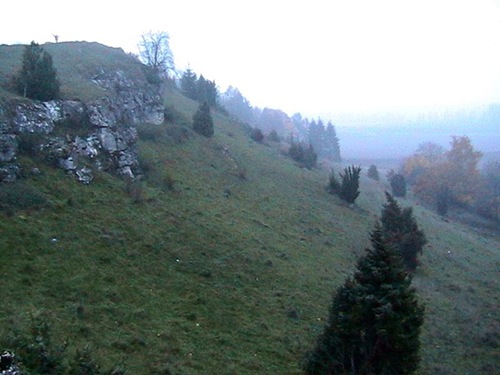The town of Nordlingen in the Donau-Ries district of Bavaria, Germany, is unlike any other town in the district. In fact, it's unlike any other town on the whole planet. This pretty medieval town, with a population of 20,000, is situated entirely inside a massive meteorite crater 25 km across. This crater called the Nördlinger Ries, was formed some 14.5 million years ago when a meteor about a mile across slammed into Earth. It was only less than fifty years ago that evidence emerged which established the true origin of this town.

For years, it was believed that the shallow depression in the middle of which the town is situated was a volcanic crater. Then in 1960 two American scientists, Eugene Shoemaker (of comet Comet Shoemaker-Levy 9 fame) and Edward Chao, proved that the depression was in fact, caused by meteorite impact. While visiting a church in the town of Nordlingen, Shoemaker reportedly scratched its walls to see what it was made of and was delighted to discover shocked quartz, a type of rock that can only be formed by the shock pressures normally associated with meteorite impact. Subsequent exploration of the strange rock formations of the Ries conclusively established that the crater was caused by a meteor impact.
There is another impact crater the Steinheim crater, about 3.8 km in diameter, located about 42 kilometers west-southwest from the centre of Ries. These two craters are believed to have formed nearly simultaneously by the impact of a binary asteroid.

Nordlingen - for centuries unsuspecting people have been living inside a crater


This hill is actually the rim of the crater













"Aerial view of the town. The crater rim distinctly visible "
ReplyDeleteThe circle that you see is the medieval wall of the city, not the crater rim. (You yourself said it was 25 km across, that isn't 25 km by a long shot.)
Nordlingen is not unique as being the only town located over the remains of a meteoric impact. The town on Manson, Iowa is also located in (over) a crater. However, this is not widely known as, during the last ice age, glaciers filled the crater in with dirt and debris, so that now the crater, and thus the town, are on the same level as the surrounding countryside.
ReplyDelete@Bart and Ian: Sorry. That was a mistake. I apologise.
ReplyDeleteDAS GOOD, DAS BOOT. - Bryan Rebhorn
ReplyDeleteWouldn't it just be hilarious if a meteorite was to hit the exact same spot again?
ReplyDeleteA sense of universal repetition.
Middlesboro, Kentucky is also built inside of a crater.
ReplyDeleteSo photoshopped
ReplyDeleteSo if the pics do not really show a creator, all we are looking at is a typical bavarian township protected by a city wall ... still nice though.
ReplyDeletePhotoshopped? Ok, obviously you've never been to that town then! And crater is not right up to the walls of the city is further away from it. When you are driving towards the city and away from it, they ARE visible you go buy them and part of it is somewhat flatten to allow for better flow of the road when the road was being done.
ReplyDeleteIf you think one town in a crater is impressive, then you will really be impressed by this. As a child I lived in the small town of Chelmsford, Ontario, at the geographic centre of the Sudbury basin. The Sudbury basin is the highly eroded reminent (roughly 20 x 40 miles) of an impact crater estimated to have been roughly 100 miles in diameter at the time of its formation almost 2 billion (2 thousand million) years ago. The basin doesn't have just one community in it. It has several, including the city of Sudbury itself.
ReplyDelete